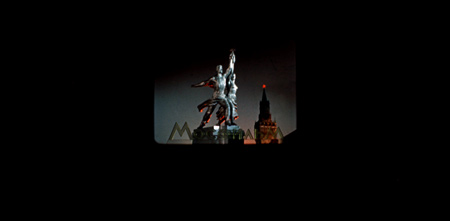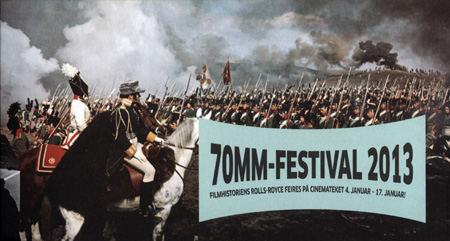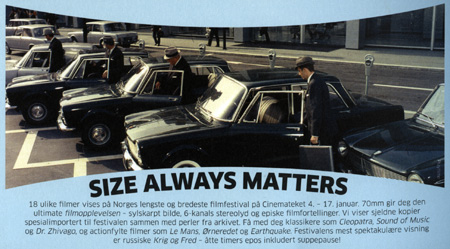Oslo 70mm Film Festival | Read more at in70mm.com The 70mm Newsletter |
| Written by: Paul Sutton | Date: 27.01.2013 |
 The Oslo 70mm Festival should be on the attendance calender of all Big
Screen Film fans because, of all the countries in the world, when it when it
comes to Widescreen cinema, Norway is bettered only by America (Cinerama)
and England (David Lean). The Cinemiracle of "Windjammer"; the 70mm
"Pathfinder"
(1987); and the American-backed 70mm spectacular,
"Song of Norway", which outgrossed every film released in
London in
1970, gives Norway the edge over its closest rival, Russia; a point
confirmed by the 2013 Oslo 70mm film festival which showcased truly great
prints of Russiaís mightiest 70mm films: Sergei Bondarchukís 7-hour version
of "War and Peace"; "Anna Karenina" (1967); Dovzheknoís
"The Story of the Flaming Years", and the 1967 film of the Bolshoi
Ballet. All in fine full colour with gorgeous multi-track magnetic sound. The Oslo 70mm Festival should be on the attendance calender of all Big
Screen Film fans because, of all the countries in the world, when it when it
comes to Widescreen cinema, Norway is bettered only by America (Cinerama)
and England (David Lean). The Cinemiracle of "Windjammer"; the 70mm
"Pathfinder"
(1987); and the American-backed 70mm spectacular,
"Song of Norway", which outgrossed every film released in
London in
1970, gives Norway the edge over its closest rival, Russia; a point
confirmed by the 2013 Oslo 70mm film festival which showcased truly great
prints of Russiaís mightiest 70mm films: Sergei Bondarchukís 7-hour version
of "War and Peace"; "Anna Karenina" (1967); Dovzheknoís
"The Story of the Flaming Years", and the 1967 film of the Bolshoi
Ballet. All in fine full colour with gorgeous multi-track magnetic sound.
The screening of "War and Peace" was a marvel to behold, almost as much as the film itself, because the average age of the patrons, in the packed cinema, was probably the late twenties. There were even a couple of teenage boys. All watching in enrapt silence (Iíd told the young woman sitting next to me that she had to put her knitting away, and she did). Iíd prepared for the film itself (in Russian with Norwegian subtitles) by reading the first 47-pages of the novel. Time ran out. The film itself didnít need translating. If you leave after six hours, Napoleon wins. He loses if you stay until the end, and thereís a sweetly sad scene, stylishly filmed in the low lights of night and early morning, of a young Russian cavalry officer making his first (I think) and his last charge. There is impressive authenticity in the faces and the performances of the landed Russian gentry in the ballroom scenes early on, where the focus is on the aged, the elderly, the dying and the leading man, Pierre, who seemed to me to be miscast. I wondered why the leaders of high society and the military were so impressed by the stout, bespectacled, sweaty, fellow around whom the film is largely writ, when it dawned on me that he is played by Sergei Bondarchuk, the director himself! Bondarchuk has some of Orson Wellesís talent, much of his girth, all of his ego, and none of his genius. The battle scenes were by numbers and the numbers were big. The aftermath of the first, or thereabouts, was musical. A platoon of Russian foot-soldiers broke into song and sounded very much like the Bolshoi Operatic chorus, which they probably were. On the whole, I preferred Bondarchukís other 70mm Napoleon war film, "Waterloo" (1970), which I saw on the splendid curved screen at Karlsrhue last year. The main reason I prefer "Waterloo" is that big films about big personalities need ĎStar Performancesí. "Waterloo" has the vividly contrasting star performances of a brooding, intellectual, Rod Steiger and a flippant floppish Christopher Plummer, both at the top of their game. "War and Peace" has five or six hours of Bondarchuk waddling through chandeliered room and muddy field with an almost guilty look on his face that says: ďI canít believe I got away with this. I only demanded the lead role as a bargaining point. I didnít think they would take it seriouslyí. | More in 70mm reading: 10th Oslo 70mm Festival, January 2013 70mm Festival in Oslo 2010 The 9th Oslo 70mm festival The 2004 Oslo 70mm Film Festival The First Oslo 70mm Festival 2000 70mm Retro - Festivals and Screenings Internet link: youtube.com Norwegian Film Institute |
 The film screened in three parts over eight hours. During the middle break,
free fresh soup was provided. Being brought up on a proudly bland English
diet I had no idea what it was but it was delicious. The film screened in three parts over eight hours. During the middle break,
free fresh soup was provided. Being brought up on a proudly bland English
diet I had no idea what it was but it was delicious.The festivalís two-week spread, over what was a busy work period for me, prevented me from seeing the "Anna Karenina" and the Bolshoi film, but I did see "The Story of the Flaming Years", listed at 91-minutes but running at about 97-minutes, must be the shortest of the Widescreen Spectaculars. It was a tale of The Great Patriotic War in which a square-jawed young Russian soldier (cast more for his waxy good looks than his tin-hollow acting ability) is wounded in the Nazi tank invasion but recovers to marry his village sweetheart (I think) and is there in the court room climax when Nazi psychopaths who ordered the (off-screen) slaughtering of a whole class of teachers and kids are put on trial. The main reason for seeing the film is, of course, the photography. The signature shot of Dovzheknoís silent years was figures in a landscape, tiny figures photographed within giant skies and, more often, within giant landscapes. Tiny figures on the horizon of hills. In this, the last film to carry Dovzheknoís name (as writer), the humans are still on hilltops but they now occupy the greater part of the frame. The DPs favourite trick here is to photograph people (on hilltops) with the lens pointing into the sun, the image thus rendered as dark as night, and the sunlight transformed into a sort of blue moon light, the camera now tracking from high to the sun/moon reflected in the river down below. | |
 The Russian films were only one part of the Festival. The usual favourites
were there, of course, though not always in formats that made them required
viewing. Iím not one to leave the house for a digital screening. 4K is the
embarrassing little brother of tomorrows 20k. Iíd seen 70mm prints of Tatiís
"Playtime" (restored with the numbing over-extended restaurant scene)
and "Cleopatra" (as dull-as-"Ben-Hur") in Seattle, so I caught
up with the Festival in Oslo for a 70mm screening of "Airport" which
Iíd previously only seen on DVD. I loved it. And it gave me a new screen
hero. Iíd never before noticed how good Arthur Kennedy is, because Iíd never
before seen a performance of his on the big-screen. Heís quite a presence in
"Airport", the cigar-chewing athletic dependable uncle type, who is
called upon to save the day, a role not unlike the one he gives in the
mighty-mighty "Earthquake" which screened in Oslo on the following
day in 70mm and glorious Sensurround.
Bill Lawrenceís own miracle work in
presenting Sensurround screenings of
"Earthquake" in the UK have been
documented on this site. Iím sure Billís screenings were wonderful. In Oslo,
thanks to German genius (the engineer Stefan Scholz) and Jan Olsenís
ambition and local connections, the screening of "Earthquake" could
properly be described as Biblical. Sixteen or more four-foot-long
bass-speakers, weighing more than one-and-half tons, generated about 115
decibels of rumble, all perfectly queued and monitored by the maestro in the
projection booth. It literally shook the paint from the walls, the dust from
the rafters, and brought a smile to my face so wide I could have been
mistaken for the San Andreas Fault. Naturally the screening was completely
sold out, with an impressive waiting list for returns. The Russian films were only one part of the Festival. The usual favourites
were there, of course, though not always in formats that made them required
viewing. Iím not one to leave the house for a digital screening. 4K is the
embarrassing little brother of tomorrows 20k. Iíd seen 70mm prints of Tatiís
"Playtime" (restored with the numbing over-extended restaurant scene)
and "Cleopatra" (as dull-as-"Ben-Hur") in Seattle, so I caught
up with the Festival in Oslo for a 70mm screening of "Airport" which
Iíd previously only seen on DVD. I loved it. And it gave me a new screen
hero. Iíd never before noticed how good Arthur Kennedy is, because Iíd never
before seen a performance of his on the big-screen. Heís quite a presence in
"Airport", the cigar-chewing athletic dependable uncle type, who is
called upon to save the day, a role not unlike the one he gives in the
mighty-mighty "Earthquake" which screened in Oslo on the following
day in 70mm and glorious Sensurround.
Bill Lawrenceís own miracle work in
presenting Sensurround screenings of
"Earthquake" in the UK have been
documented on this site. Iím sure Billís screenings were wonderful. In Oslo,
thanks to German genius (the engineer Stefan Scholz) and Jan Olsenís
ambition and local connections, the screening of "Earthquake" could
properly be described as Biblical. Sixteen or more four-foot-long
bass-speakers, weighing more than one-and-half tons, generated about 115
decibels of rumble, all perfectly queued and monitored by the maestro in the
projection booth. It literally shook the paint from the walls, the dust from
the rafters, and brought a smile to my face so wide I could have been
mistaken for the San Andreas Fault. Naturally the screening was completely
sold out, with an impressive waiting list for returns. The screening was followed by "The King and I". Deborah Kerr quavering gorgeously with repressed passion for a strangely long-nippled Yul Brynner, etcetera, etcetera. The image lacked a little sharpness and seemed cropped on the left-hand side. In one shot, Brynner kneels with outstreched arms. The left arm didnít make it onto the screen, suggesting to me a 35mm blow-up? A good film though. I was almost the only male in a roomful of women watching it. The following day a roomful of men watched "Le Mans", the great Steve McQueen film about the 24-hour French car race. Relentlessly motion-packed visuals layered over an almost dialogue-free multi-track magnetic soundtrack rightfully filled throughout with awesome engine sounds. I adore it. I was told that the print had been stored away on ice since its release in 1971. It was glorious, unfaded, in shining full colour, with a few tiny white Norwegian subtitles. | |
 Getting to the
Cinemateket in Oslo from my house in Cambridge, England was
cheap and easy. A £31 round-trip flight from Stansted to Rygge, took less
than two hours (plus two-hours waiting time); and was followed by a £29
round-trip coach from Rygge to Oslo (which took about an hour). The coach to
Oslo departs in harmony with the flight, i.e. if the flight is delayed the
coach will wait (this is called an ĎIntegrated Transport Systemí and is
something we should have in the UK.). Coach tickets can be bought in cash or
credit card on the coach. Curiously debit cards werenít accepted. Anyone
flying Ryanair though should make sure they have a pair of noise-cancelling
headphones and an ipod (or similar) loaded with loud music to drown out the
tannoyed advertisements for tatty low-quality products (scratch cards and
the like) which are bombarded at you on all Ryanair flights. I had mine with
me and so didnít have to listen to a single one. Getting to the
Cinemateket in Oslo from my house in Cambridge, England was
cheap and easy. A £31 round-trip flight from Stansted to Rygge, took less
than two hours (plus two-hours waiting time); and was followed by a £29
round-trip coach from Rygge to Oslo (which took about an hour). The coach to
Oslo departs in harmony with the flight, i.e. if the flight is delayed the
coach will wait (this is called an ĎIntegrated Transport Systemí and is
something we should have in the UK.). Coach tickets can be bought in cash or
credit card on the coach. Curiously debit cards werenít accepted. Anyone
flying Ryanair though should make sure they have a pair of noise-cancelling
headphones and an ipod (or similar) loaded with loud music to drown out the
tannoyed advertisements for tatty low-quality products (scratch cards and
the like) which are bombarded at you on all Ryanair flights. I had mine with
me and so didnít have to listen to a single one.The cinema, at the Norwegian Film Institute, is a seven-minute walk from bus station (out past the giant bronze tiger and into the centre of the city). The cinema itself is a 220-seater (or thereabouts). The screen is flat and is smaller than ideal for 70mm film screenings but the sight-lines and the leg-space are better than they are at Bradford, Seattle, Karlsruhe. The sound system is fantastic. The institute also houses a small free museum on Norwegian cinema, the highlight of which, with respectful nod to the proud Kon-Tiki exhibitions, and a photograph of Hammer Horrorís Julie Ege, are the puppets and sets from many of Ivo Caprinoís cheerful animations. Anyone unfamilar with his work, which is as popular in Norway as Nick Parkís is in England, should try to get a DVD of his feature-length "FlŚklypa Grand Prix", but my personal favourite is this little tale about a boy, a violin, a shilling or two, a giant (and the gallows). Itís called "Veslefrikk med fela": | |
| Go: back - top - back issues - news index Updated 22-01-25 |
